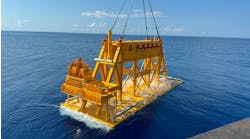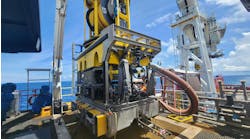Mechanical and chemical solutions predominate
William Furlow
Technology Editor
- StrataLock is a formation-control-while-drilling product developed by Halliburton that may have applications in holding back shallow water flows. [16,744 bytes]
- Image B [19,145 bytes]
- One SWF solution is based on a riserless drilling project involving a subsea blowout preventer (BOP) and rotating drilling head mounted to the initial casing joints by an inflatable packer. [17,204 bytes]
Shallow water flows, or the flow of water and entrained sand from sub-seafloor strata up by the drill bit or surface casing, are a recently encountered phenomenon found in the Gulf of Mexico, West of the Shetlands, the Norwegian Sea, Southern Caspian Sea, and North Sea. The flows are typically found in deepwater. In the case of the Gulf of Mexico, they are found off the continental shelf.
Shallow water flows are thought to form in one of three ways.
- Channel sands: Deposits of channel sands, clean sands laid down in a deltaic environment, shift over time so that new sand deposits create a super-imposed structure.
- Turbidite sands: Sands deposited in the Gulf of Mexico on the continental slope, which runs at a steep angle between the continental shelf and the deepwater basin. In strong turbidity currents, these sands slide down the slope at high speeds, to form turbidite sands on the sea floor. The result is rapidly formed, coarsely graded turbidity deposits.
- Rotated slump block: In this condition, the face of the continental shelf slides down like an undersea avalanche of sand, to deposit rapidly onto the deep basin.
Mechanical solutions
A Baker Hughes Inteq JV with Transocean, called DeepVision, is developing a riserless reeled drilling system for deepwater. This continuous pipe system uses large-diameter tubulars to drill under balanced or near balanced through the SWF zone. The project is being funded by a closed group of oil companies, including the Shell Group, to avoid the delays associated with a traditional JIP.At the same time, Williams Tool and Dr. Adam Ted Bourgoyne Jr., Dean of Engineering at Louisiana State University and a principal in Bourgoyne Enterprises are also studying the problem. Don Hannegan, Vice President and GM of Williams Tool is also leader of the SPE Unbalanced Drilling and Completions Technical Interest Group. The group is working on a riserless drilling project involving a subsea blowout preventer (BOP) and rotating drilling head mounted to the initial casing joints by an inflatable packer.
"Our idea is to address a different problem than riserless drilling in deepwater," Hannegan said. The group will use riserless technology to address only the first 1,000 ft below the mudline, in order to get past the potential flow zones. This would provide the back pressure needed to contain the SWF and allow the initial casing joints to be set.
Using this technology, the operator would set one joint of casing at the mudline, install the "virtual riser," which includes a subsea rotating control head and high-presssure BOP mounted to the casing by an inflatable packer. This virtual riser allows the operator to maintain back pressure on the SWF.
The back pressure comes from the mud pumps, which pump seawater through the bit and up the annulus against the control head. The mud pump pressure can be regulated by controlling the amount of back pressure needed to contain, but not invade, the formation. One advantage of this solution is that the packer, BOP, and rotating control head are all off the shelf hardware that have been proven in the field, Hannegan said.
If the shallow water diverter currently under development by an industry coalition including Amoco, Conoco, and Chevron is included, there are a total of three hardware JIPs currently targeting this emerging problem.
Mike Tweedy, Senior Deepwater Advisor for Chevron's Deepwater Team said these solutions, while beneficial, will not eliminate the SWF phenomenon. In fact, there are some SWF conditions these technologies might actually aggravate. He used sand flows as an example.
Tweedy explained that in such a case, the diverter his group is working on could lead to a washout if the flow were to get around the subsea BOP. In a sand flow situation, the well is being drilled riserless. When it hits the sand flow, the SWF zone begins producing a massive amount of water, sand, and debris.
These flows can be spectacular. In a video presentation at the seminar, one operator showed a tape obtained by an ROV camera of a SWF producing plumes of sand and debris that boiled up 60 ft from the seafloor. One attendee described it as an endless column of black water building huge mounds of debris around the subsea BOP stack.
With flow rates as high as 25,000 b/d, the water in the flowing sand is usually quickly depleted. The sand in the flow zone then compacts and gives up its porosity under the pressure, which actually increases the flow. It is suspected that this was the situation at Ursa.
Chemical alternatives
According to Tweedy, Chevron and Shell are both looking at stabilization polymers or resins that, when put in place, would seal off the SWF zone and add strength to sediments. This would be a particularly attractive solution in the above mentioned sand flow situations in which stopping the flows early is critical to saving the well.One product that has shown promise is currently being applied to the rubble zones above and below a salt intrusion. These areas are technically stressed, meaning there is a risk of the rubble entering the wellbore. Halliburton Energy Services (HES) has developed a line of formation-control-while-drilling products that includes a water-based epoxy resin that may have SWF applications. According to Ronnie Faul, Technical Analyst with HES, this product can be combined with a water-based or oil-based drilling fluid to improve the integrity of a formation, in effect increasing the fracture gradient and decreasing the pore pressure.
The product, marketed under the name StrataLock, penetrates and seals the pores of the formation. Faul said the product has been tested at compressive strengths up to 10,000 psi, higher than any formation strength it is likely to encounter. The product has also been tested at temperatures as low as 50° F, which is similar to those found in SWF zones in the Gulf of Mexico.
In an SWF zone, the product could be transported downhole with a heavy weight mud to hold back the flow zone while the epoxy penetrates the formation and sets. In addition to sealing the formation, Faul said StrataLock contributes to a stronger mud cake. The placement and pump times can be tailored from 2 to 12 hours.
This epoxy does not act as a kickoff plug and is easy to drill through, according to Faul. There has been some early discussions about applying this product to a SWF field, "Faul said there has been some early discussions about applying this product to a SWF field, and he anticipates a SWF application before the end of the year."
Dan Mueller, Senior Leader of Cementing R&D for BJ Services said his company has a sodium silicate pill it uses for control of unconsolidated sands. He said this is a relatively common product, and could also have SWF applications if it were applied to the right strength flow before it was flowing too hard.
Mueller said the key to this product and any chemical treatment for this condition, would be to kill the flow first so the product would have time to work. An operator who hits a shallow water flow zone and continues to drill without killing the flow cannot expect a service company to come in and remediate the strong flow with a resin or other chemical.
He stressed that it is essential that the well is killed before any treatment is considered. The worst mistake he sees is an operator drilling through the flow zone expecting the pressure to deplete and the problem to basically go away.
Future of SWF
Current SWF solutions attempt to contain, as opposed to control, the problem by isolating the zone and sealing it off. Operators are looking beyond this method, especially in deepwater fields, because it can hamstring a casing program, sacrificing a full string of casing in order to isolate the zone.Mueller pointed out that not only does this technique sacrifice a casing string to isolate the zone, but is limited to wells that encounter only one SWF. There also are the traditional risks associated with setting and cementing a casing string that are only aggravated by the SWF zones.
According to Tweedy, there is now another reason to look further for long-term solutions. Often, an operator will seal off a SWF zone, continue drilling, complete the well, and move on, confident that the zone is gone for good. Recent events seem to indicate that this is not always the case.
If these zones are strong enough, they can slowly work their way around a casing string and cement job to wash out the well. This was the situation at Ursa, where Shell and partners finally had to move to a different site to avoid the torrential flows.
Equally unsettling is the phenomenon of intermittent SWFs. In this situation, an operator may believe he has overcome the SWF, when in fact he has only depleted the pressure feeding the zone. Once sealed off, this pressure builds again until it is able to overcome the remedial steps.
Often there will be as much as a week of inactivity before the SWF resurfaces. The most unsettling aspect of this scenario is that the recurrence doesn't happen one time, but continually, so that it is impossible for an operator to ever be sure he's licked the problem. Tweedy said there was discussion at the June seminar about returning to completed wells that demonstrated SWF problems and conducting a video survey of the seafloor, using an ROV, to ensure the phenomenon has not returned.
Is Shell shifting strategies?
Among those on the itinerary to speak at the US Minerals Management Service shallow-water flows (SWF) seminar were a number of Shell Deepwater staff members. After the $150 million Ursa washout, attributed to violent SWFs, the industry was eager to hear what the company had to say. According to Don Jacobsen, Manager of Drilling and Subsea Intervention for Shell Deepwater, Shell was not ready to discuss the Ursa problems because the company was still in the middle of redrilling the wells. He said Shell will prepare an IADC/SPE paper on the Ursa drilling program for presentation early next year.Bill Houseman, with the MMS, discussed all the public information surrounding Ursa, but added little to what had already been released to other operators. In addition to not discussing Ursa at the seminar, Shell has also dropped out of a Joint Industry Project to develop a subsea diverter that would help alleviate shallow water flow problems. Those close to the project suspect these moves by Shell may indicate that the operator is attempting to protect its own investment in technological solutions. However, Jacobsen said Shell pulled out of this JIP for technical reasons, and it decided to pursue another avenue of research it felt showed greater promise.
Jacobsen said Shell is actively taking on partners in several new deepwater exploration projects.
While Shell may be taking on new partners, the move to a privately funded SWF solution makes sense from a competitive viewpoint. Shell has been at the helm of some major groundbreaking deepwater projects, including Mensa, Auger, and Ursa. Taking on partners in such projects lowers the cost and risk, but also forces Shell to share not only the profits, but more importantly, the hard-won technology. Shell Deepwater remains the overwhelming leader in the deepwater US Gulf of Mexico at this point.
Copyright 1998 Oil & Gas Journal. All Rights Reserved.


